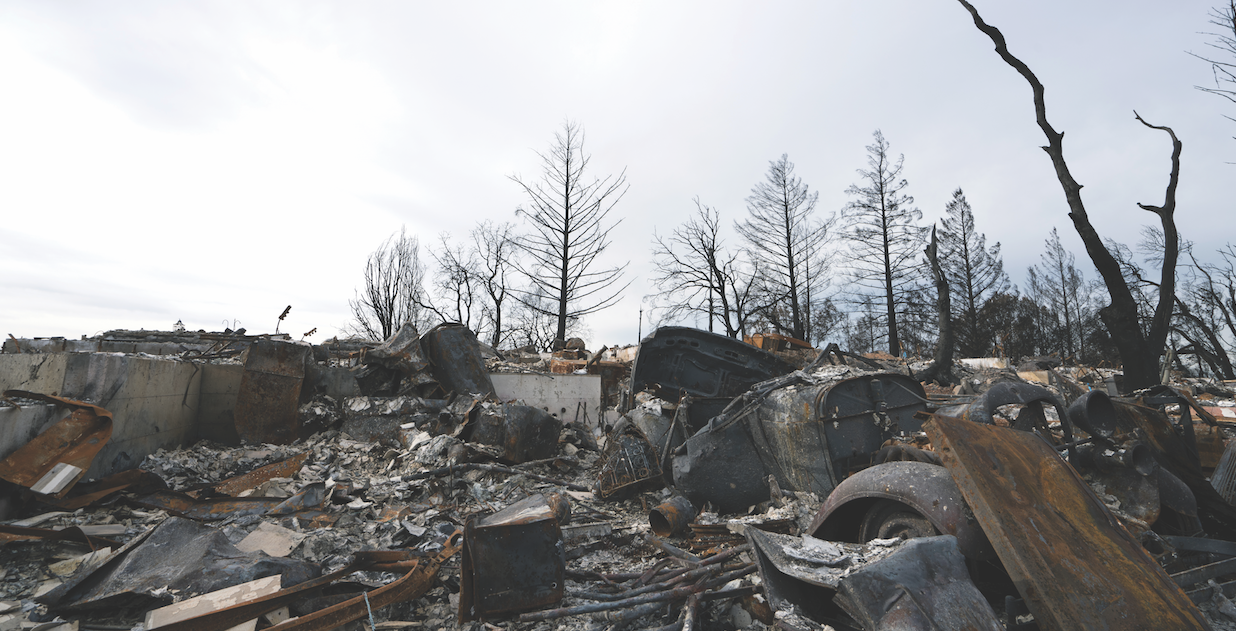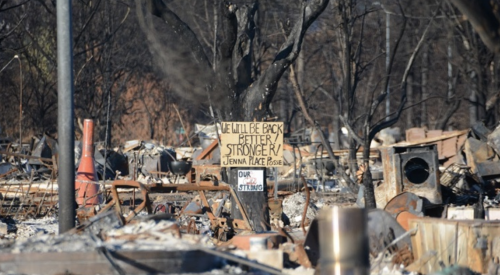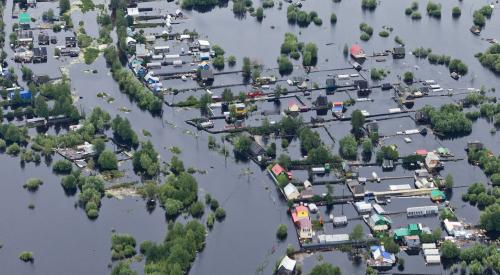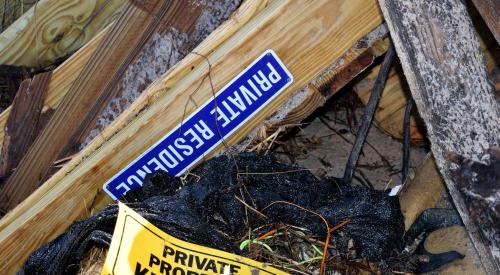In mid-December, Synergy Communities by Christopherson, a developer and general contractor that started 35 houses in 2017, opened its Rebuild Center out of a sales trailer in the Coffey Park neighborhood of Santa Rosa, Calif., where wildfires destroyed 1,500 homes in October.
The four fires that ripped through Sonoma County in Northern California that month destroyed 8,400 homes and other structures, causing some of the worst damage in the state’s history. Synergy is one of several local builders that are now actively involved in rebuilding Sonoma County, which by some estimates could take as many as 15 years to complete. Santa Rosa alone lost 5 percent of its total housing stock.
Rebuilding and repairing after natural disasters—fires, floods, high winds, earthquakes, mudslides—is different from new construction. It’s more like custom remodeling, with each homeowner having a different level of equity, insurance, budget, and commitment. And while there are exceptions, production builders generally see their post-disaster roles as being more philanthropic than repair- or rebuilding-oriented.
“We don’t employ trade crews directly, so we have a limited opportunity to facilitate repairs,” explains Jim Zeumer, PulteGroup’s VP of investor relations and corporate communications.
Taylor Morrison is looking at possibly acquiring “a well-located community” with 15 to 20 lots to build in markets disrupted by disasters, says Alan Laing, executive VP of operations. But he concedes that production builders “aren’t set up to handle custom rebuilding.” Laing also notes that it would be difficult to find trade labor for rebuilding, on top of what Taylor Morrison needs for its existing backlog.
As a result, small and midsize builders and contractors do the lion’s share of disaster rebuilding and repair, including helping displaced homeowners locate construction documentation for insurance claims and rebuilding permits, and dealing with adjusters whose rebuild cost estimates, say many builders, rarely reflect reality.
But don’t expect these builders to be pioneers in resilience. Despite evidence that natural disasters are increasing in frequency and intensity, most builders say they aren’t going beyond what local building codes or the Federal Emergency Management Agency (FEMA) require, at least in part because of cost and time constraints.
A look at three markets—Santa Rosa, Calif., Houston, and Baton Rouge, La.—shows how builders in these locales are responding to natural disasters.
RELATED
- The Need for Resilient Construction Is Real. How Are Home Builders Responding?
- Roadblocks to Resilient Construction
Santa Rosa, Calif.
-
October 2017: The Tubbs Fire engulfed more than 36,000 acres
-
More than 5,500 structures were damaged or destroyed
About two and a half years ago, Lenox Homes, a Lafayette, Calif.-based builder, started a 32-home subdivision in Santa Rosa. By some miracle, and despite two evacuation alerts, that subdivision was spared during the fires. “It was total chaos,” recalls Lenox president Daniel Freeman. (Image: StevePB via Pixabay)

In the aftermath, Lenox Homes suspended its normal sales and offered the 17 homes and two models in its inventory to those who got burned out of their houses. Within three days, Lenox had received 200 inquiries. Half were from investors. Lenox decided to sell only to displaced people, and over the following seven to 10 days started contacting prospects. Freeman says the homes should be completed by this spring.
Freeman also met with Santa Rosa’s economic development department about Lenox helping with future rebuilding and has met with homeowners associations about rebuilding clusters of burned homes using a limited number of floor plans, like a production project. One HOA is fully insured and all of its owners have “complete losses,” Freeman says, so there wouldn’t be disputes with insurers about replacement costs.
Freeman says the Santa Rosa community is united on rebuilding, spearheaded by its assistant city manager and director of planning and economic development, David Guhin. But, he adds, “there’s a long row to hoe ... . A lot of subs are gone.” and update their damaged houses, “so each project is unique in its redesign.”
The city of Santa Rosa had construction plans on file for just one subdivision. Fortunately, Bassenian Lagoni Architects, a Newport Beach-based architectural firm that had designed 1,000 homes in Fountaingrove’s subdivisions, had archived the construction plans and has been providing PDFs to homeowners. The firm hired Michael Rupard, a former assistant director of architecture for Toll Brothers, to manage what has become a completely new business for Bassenian Lagoni: to turn around plans for each homeowner within seven days for insurance and permitting purposes. “A lot of people in our company remember these homeowners and have been working nights and weekends to provide them with the plans,” says Jeff LaFetra, Bassenian Lagoni’s president. The city of Santa Rosa has smoothed the permitting process by allowing homeowners to make changes to their homes’ interiors as long as the footprints and elevations remain the same.
Locating Old Construction Plans
Gateway Builders, another general contractor in Santa Rosa, is rebuilding burned homes constructed by Petaluma, Calif.-based Cobblestone Homes in four subdivisions in Santa Rosa’s Fountaingrove community. (Matt Watson, Gateway’s president, is the son-in-law of Cobblestone’s president, Joseph Keith.) Fire destroyed about 1,200 of those homes, which Cobblestone had built during the late 1990s and early 2000s. Watson says many owners there want to customize and update their damaged houses, “so each project is unique in its redesign.”
The city of Santa Rosa had construction plans on file for just one subdivision. Fortunately, Bassenian Lagoni Architects, a Newport Beach-based architectural firm that had designed 1,000 homes in Fountaingrove’s subdivisions, had archived the construction plans and has been providing PDFs to homeowners. The firm hired Michael Rupard, a former assistant director of architecture for Toll Brothers, to manage what has become a completely new business for Bassenian Lagoni: to turn around plans for each homeowner within seven days for insurance and permitting purposes. “A lot of people in our company remember these homeowners and have been working nights and weekends to provide them with the plans,” says Jeff LaFetra, Bassenian Lagoni’s president. The city of Santa Rosa has smoothed the permitting process by allowing homeowners to make changes to their homes’ interiors as long as the footprints and elevations remain the same.
Adjusters Underestimate Costs
Gateway’s Watson expected reengineered plans to be ready by January 2018 and for work to start soon after. He has been approached by a local credit union about offering a loan program that would provide 90 percent of the appraised value of the house. A bank is interested in putting together a construction-to-permanent mortgage plan for owners wanting to rebuild.
The biggest impediment to rebuilding, Watson says, is adjusters whose estimates “are well below what it would cost to rebuild the house.” Gateway hired its own independent adjuster, as “everything is a negotiation” with insurance companies. But delays may be too much to bear for some homeowners: Watson thinks that 20 to 30 percent will choose not to rebuild and will just sell their lots.
Eric Keith, co-owner of NorthBay Environmental, a Santa Rosa-based contractor that specializes in insurance restoration work, was once an adjuster himself. He says post-fire adjuster estimates have been coming in at around $180 per square foot. “Maybe if we were in North Carolina,” he says, “but in Northern California, no way.” He adds that rebuilding costs are more likely to be nearly double that.
NorthBay is focusing on Miramonte, a neighborhood in Santa Rosa where 58 of its 65 homes were reduced to ash. The company has formed a new division, Sonoma County Builders. Eric and his brother, David, asked their father, Ed, to come out of retirement to manage the reconstruction effort.
From its Rebuild Center, Synergy Communities by Christopherson is offering 14 floor plans ranging from 1,120 to 2,150 square feet, says partner Brian Flahavan. The Rebuild Center also offers free insurance claim guidance and rebuild assessments and will buy lots from owners who decide to sell. Synergy is also selling 30 new homes in Coffey Park that should be completed by this spring and summer.
Flahavan says his company isn’t so concerned when a burned home’s original plans aren’t available. “We’re not using them anyway; the houses were 30-plus years old,” he says, and need to be brought up to code. His intention was to start eight homes per month and eventually get up to 16 per month. He says most owners in Coffey Park are adequately insured, but it all depends what insurers allow to get owners as close to recovery value as possible.
Houston
- August 2017: Hurricane Harvey drops nearly 52 inches of rain
- $125 billion in damage; more than 120,000 homes damaged or destroyed
- Just 15 percent of Houston homeowners have flood insurance
- Many homes destroyed were outside of mapped floodplains
A recent analysis in the Los Angeles Times of the wreckage caused by Hurricane Harvey divides Houston’s housing into two eras: pre- and post-1985. That was the year when the city and surrounding Harris County started requiring homes to be built above expected flood levels. The “pre” homes, which currently number around 3 million in the county, have consistently been the most vulnerable to storm flooding, and in Houston, Hurricane Harvey was the third 500-year flood in three years. The “post” homes, especially those built after 2007, have pretty much escaped serious flood damage.

Some Houston builders have joined forces to help those who were displaced by flooding and damage from Hurricane Harvey. (Image: Adobe Stock)
Because flood-related construction standards were changed after Hurricane Alicia hit Houston in 1983, “only 3 percent of ‘newer’ homes have been flooded, and the newer master planned communities weren’t flooded at all,” says Will Holder, former president of Trendmaker Homes.
“The first litmus test is consumer confidence. It’s hard to sell in a flooded community without an engineering solution,” observes Laing of Taylor Morrison. In mid-January, the builder was negotiating to buy a parcel of land in Houston, and due diligence included satellite photos of the property before and after flooding. “We have no interest in building where there’s [persistent] flooding,” Laing says. “There’s no gain in that.”
None of David Weekley Homes’ Houston-area houses were flooded by Harvey. Still, the builder is trying to help. Weekley donated $1 million to the nonprofit HomeAid Houston to start BuildAid, through which Weekley and three other companies—Trendmaker, Taylor Morrison, and Partners in Building—are contributing project management and purchasing services, at no profit to the builders, says David Weekley, chairman of David Weekley Homes.
Weekley says this consortium is offering to rebuild houses for about $35,000 less than market cost, with quality finishes. Holder adds that BuildAid is offering to arrange financing: 30-year loans at 0 percent.
Lennar committed $500,000 to BuildAid, and Taylor Morrison and Perry Homes each kicked in $250,000. BuildAid’s goal, says Weekley, is to raise more than $5 million in rebuilding grants. As of mid-January, BuildAid had completed its first home and had received between 12 and 15 applications for aid.
Lower-Priced Products Attract Flood Survivors
Trendmaker, which closed 506 homes in 2017, pushed 30 deliveries into 2018 due to flooding. To assist flooded-out homeowners, Trendmaker established a Hurricane Harvey Assistance Fund with money raised by employees and matched by parent company Tri Pointe Group, which also donated $200,000 to the American Red Cross’ hurricane relief efforts.
Holder says most of the homes BuildAid will rebuild will have been stripped to their studs, so they’ll require new plumbing, electrical, drywall, flooring, cabinets, windows, doors, roofing, and paint. The homes won’t be expanded. Holder believes there is “enormous will” within the Houston community to rebuild sustainably and that builders there are open to any solution that helps keep houses dry.
Rain could be a precursor to brighter days for Frankel Building Group, a Houston high-end custom and semi-custom home builder that annually closes between 16 and 27 units. For years, customers had been asking for less-expensive homes. In September, Frankel announced the launch of BuildFBG, a sister company that will focus on 3,600-to-5,500-square-foot homes from 10 to 13 of Frankel’s most popular house plans. BuildFBG will use the same trades as Frankel and will build homes for $35 to $40 per square foot less.
As of late January, BuildFBG had written 14 contracts. Most of the customers are flood victims whose houses had been flooded once or twice, says copresident Scott Frankel. “Our decision to expand into semi-custom homes wasn’t flood-related originally; it just worked out like that,” says Scott’s brother and copresident Kevin Frankel. BuildFBG will handle demolitions—it had 15 in the works at the beginning of this year—but it won’t get into water-damage restoration, preferring to stick with building new homes.
Baton Rouge, La.
- August 2016: Massive flooding
- Per FEMA, more than 41,000 residential structures destroyed
- Flooding damaged nearly 21,000 homes in nearby Livingston Parish, half of its housing stock

"Flood remediation is nothing like a regular model," says Robert Carroll, co-owner of Carroll construction in Clinton, La. (Image: ArtisticOperations via Pixabay)
Some 72 percent of buildings in Denham Springs, La., were damaged by the 2016 flood, including the headquarters of DSLD Homes, one of Louisiana’s largest production builders. DSLD rebuilt its office, but like most production builders in the state stays away from flood-related rebuilding of houses, CEO Saun Sullivan says.
The reconstruction of Baton Rouge was mostly left to smaller contractors such as Clinton, La.-based Carroll Construction, which has been in business for 25 years and builds between five and 10 homes per year. In response to the 2016 flooding in Baton Rouge, the builder took on a dozen repair projects, one of which called for raising a house 8 feet 8 inches.
“We had to reinvent ourselves because flood remediation is nothing like a regular remodel,” says Robert Carroll, the builder’s co-owner. He says work often requires mildew and mold remediation, as well as removal of demolition debris; jobs that hadn’t been in Carroll Construction’s wheelhouse.
“We also had to figure out what we didn’t know,” in complying with FEMA rules, Carroll says. For example, a home can’t be repaired if the cost is more than 50 percent of the assessed value of the house. Carroll notes that in some communities, adjusters weren’t giving owners the reappraisal number they needed to reach that threshold, “so a lot of people were left doing the work themselves or paying for it out of pocket.”
Carroll says that “just about everybody” underestimated how much damage the floods caused. Carroll Construction was charging between $40 and $55 per square foot to repair a flooded house, excluding the cost of restoring air conditioning. Carroll regularly ran up against trade labor shortages and had a hard time finding building materials such as
wood trim.
Taking Cues From Past Disasters
Before his company started doing repair work, Carroll consulted builders in New Orleans who had gone through flood ordeals. One of those was Randy Noel, cofounder of Reve, in Laplace, La., and this year’s National Association of Home Builders chairman. Noel says that the most important thing after a flood event is getting “wet stuff,” such as soaked drywall, out of the house as quickly as possible. Lumber must be dried to 17 percent moisture level and treated for mold before repairs or renovation can commence.
Finding reliable door and window suppliers gets tougher after markets are flooded. Too often, Noel cautions, homeowners are overly optimistic about what insurance will cover, so it’s important to make sure they have sufficient cash up front for the repairs and upgrades they want.
Reve did about 20 demolitions and rebuilds in New Orleans after Hurricane Katrina. Noel recalls a constant battle with FEMA over reimbursements. If everything went as planned, an owner could expect to be back in a house that had been flooded within four to five months, although it took Reve a year or more to complete some projects. He also gave flooded-out homeowners a path to relocate by buying lots in St. Bernard Parish, southeast of New Orleans, and building 40 new homes there.
Natural disasters can open up business opportunities, and growing scientific evidence suggests that climate change caused by human emissions is increasing the risk of extreme weather events. It’s also projected that by 2100 up to 13 million Americans will be living in coastal regions vulnerable to rising sea levels. But post-disaster rebuilding requires a major commitment that can disrupt a builder’s workflow. Rebuilding is complicated by labor and materials shortages that worsen when hundreds or thousands of houses are damaged or destroyed by fires, floods, earthquakes, or high winds. Getting paid for rebuilding can turn into a prolonged wrestling match with adjusters and insurers.
Is post-disaster rebuilding and repair worth the hassle? It’s heartening to see how many builders have gotten involved in a variety of different ways, motivated by a sense of civic duty. A number have also set up separate businesses to handle rebuilding and repair projects. By doing so, they’ll be better prepared when disasters strike again.
Slowly, Resilience Gains Acceptance
How much resilience is enough or even economically feasible? Few builders are willing to go beyond resilience measures that FEMA and local building codes require, even as some of them acknowledge that climate change is a real threat.
Stringent Protocols
“Resilience is critical for the future,” says Frank Morse, president of Morse Homes, in Belle Chasse, La., a custom builder that completes three to eight houses per year ranging in price from $3.8 million to $8 million.

After Hurricane Katrina put New Orleans under water, designer Marianne Cusato responded with the Katrina Cottages. The dream for disaster rebuilding, she says, is homes that can be snapped together by two mid-level trades. (Photo: Pixabay)
For a number of years, Morse Homes has offered the option to build under the protocols of the Insurance Institute for Business and Home Safety’s Fortified Home program, which helps strengthen homes against hurricanes, high winds, and severe thunderstorms. Such homes feature roofs, windows, and doors that can withstand 150 mph winds, shear walls for wind loads, lightning strike controls, water sensors, and fireproofing. They are also built 3 feet above the base flood level.
The problem, Morse says, is that there hasn’t been much demand for the Fortified program, mainly because it can increase the price of a house by more than 20 percent.
Raised Foundations
There are certainly arguments in favor of building homes with an eye toward minimizing the effects of future natural disasters and events triggered by climate change.
The 60-plus homes that Frankel Building Group has constructed in The Woodlands and Bellaire, near Houston, were unscathed by Hurricane Harvey’s flooding. It was largely because the homes’ foundations were raised by a pier-and-beam construction technique that this builder devised with outside structural engineers. (Depending on house size, that technique adds $10,000 to $50,000 to construction costs.)
Alabama’s Department of Insurance received 9,000 applications for grants through its Strengthen Alabama Homes program, which offered existing homeowners in Baldwin and Mobile counties up to $10,000 to minimize losses from hurricanes and high winds by reaching the Fortified Home bronze or silver standard. Because of overwhelming demand and processing backlogs, the state suspended that program last August, but about 800 grants were issued, according to Brian Powell, the program’s director. He adds that legislation is in place to restart the program, although public and private funding is still an issue.
The National Institute of Building Sciences’ latest study on resilience, “Natural Hazard Mitigation Saves: 2017 Interim Report,” estimates that there is a $6 national benefit, in long-term construction and health savings, for every dollar spent on federal mitigation grants and a $4 benefit for every dollar invested in designing new construction to exceed select provisions of the 2015 International Building Code, the 2015 International Residential Code, and the 2015 International Wildland-Urban Interface Code.
Flood Insurance
Is flood insurance the cart before the resilience horse?
Tongue & Groove is a builder of high-end homes on coastal properties in Wilmington, N.C., where the topography makes that city a bit of a bull’s-eye for high-wind storms, says owner Mark Batson.
His company complies with FEMA building requirements that Batson says are “pretty robust” and include driving piles 30 feet below grade, installing impact-resistant windows, sealing the house up to the third floor, and adding a concrete deck. He knows that water is a homes worst enemy and favors measures to prevent intrusion, such as not exposing big walls with doors that can leak and installing high-quality millwork products.
But Batson questions whether the added expense of such resilience measures makes sense to protect a single home when other houses in the same neighborhood, built decades ago, are nowhere near as resilient and simply get blown away when a storm hits. He’s nostalgic for when beach houses were little more than shacks and were expendable. Now “they’ve become monuments to their owners’ egos,” he says, and their exorbitant values, along with the cost to insure them, are what’s driving flood insurance and resilience codes.
Resisting the Inevitable
Builders and developers have been less enthusiastic about resilience than, say, energy efficiency or sustainability, partly because the payback has been uncertain, especially on the residential side. But resilience continues to seep into codes and builders’ construction practices, by choice or mandate, slowly but inevitably.
In Northern California, Matt Watson, president of Gateway Builders, in Santa Rosa, says he and other local builders have been following the latest revisions of the city’s “Wildland/Urban Interface Fire Hazards: A New Look at Understanding Hazard Assessment Methodologies” publication. Its recommendations include using building materials and design techniques that prevent or retard the penetration of the fire into the interior of the building. Eaves and overhangs should be boxed or enclosed with noncombustible materials to eliminate edges that can trap firebrands.
Watson says he anticipates that, as a result of recent devastating fires, future revisions could include adding soffits to eaves to prevent sparks from being pulled into attics. He also favors more fire breaks around subdivisions to keep blazes from nearby forests from entering embedded communities.
“Resilience is real, and when you are in a storm- or tornado-prone area, buyers pay attention and resilience becomes marketable,” adds Jalal Farzaneh, cofounder of Home Creations, one of Oklahoma’s biggest builders.
After tornados demolished more than 3,100 homes in and around Oklahoma City in 1999, Home Creations consulted with Harold Conner, former head of The University of Oklahoma’s construction sciences program, about coming up with tornado-resistant standard features that the builder could add to its homes. These include anchor bolts, tornado straps that secure the top plate of a house to its rafters, and OSB sheathing.
In the wake of Houston’s recent flooding, Will Holder, president of Trendmaker Homes, expects more code and infrastructure changes to be made over the next two to four years, especially in the areas of upgrading and coordinating the city’s various drainage systems. There’s nothing wrong with the design of any new communities, he says, it’s just the cumulative effect that makes flooding potentially more hazardous.
Katrina Cottages 2.0
Designer Marianne Cusato, who more than a decade ago designed the Katrina Cottages—small residential houses that provided alternatives to HUD trailers for flood victims in the wake of Hurricane Katrina—envisions someday being able to offer plans and kits for temporary-to-permanent housing that can be built quickly in markets struck by natural disasters.
Cusato has teamed up with builder Craig Savage as well as the developers of the Katrina Cottages. The new company, Cypress Cottage Partners, is working in the Florida Keys and in Sonoma County in collaboration with nonprofits such as Habitat for Humanity. The aim is to develop disaster housing that’s “the whole package,” as Cusato puts it—permitting, construction, financing, additional sponsorship, and promotion.
Cusato’s new disaster rebuilding designs include studio apartments as well as one-, two-, and three-bedroom cottages, that range from around 400 to 1,200 square feet. Size depends on project need, and the plans lean toward panelized and modular construction. Cusato’s homes are designed to be expandable, as well as hurricane-, water-, fire-, and earthquake-resistant. The cottages are designed to be net-zero energy ready and adaptable to incorporate photovoltaic arrays for solar power. They’re also movable in the event that the owner relocates. The eventual goal, Cusato says, is to make each stage of construction simple and light enough so that two mid-level skilled tradespeople could assemble it. At some point, Savage and Cusato envision their “houses in a box” being warehoused.













